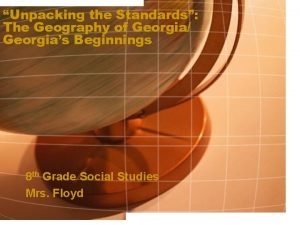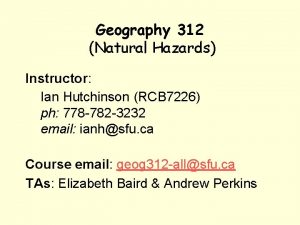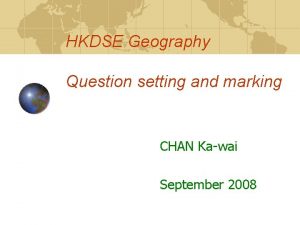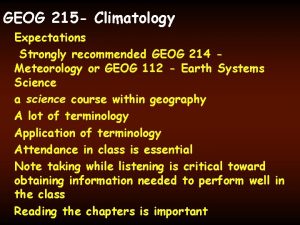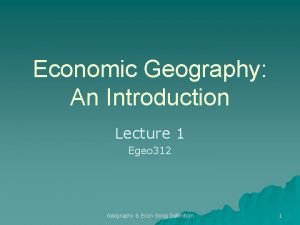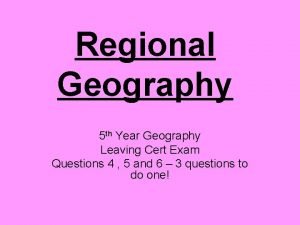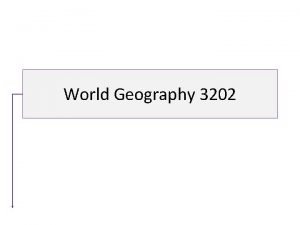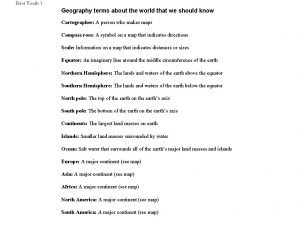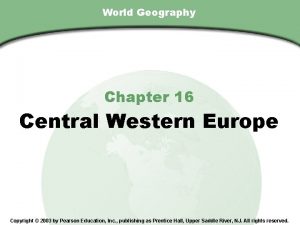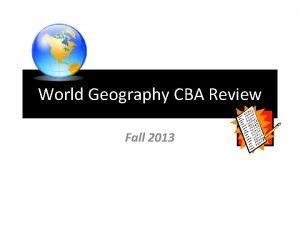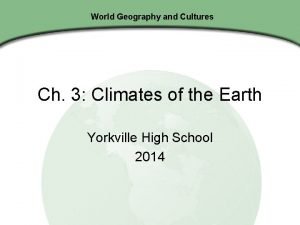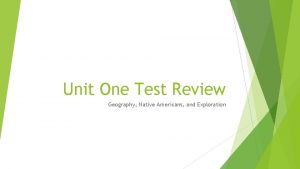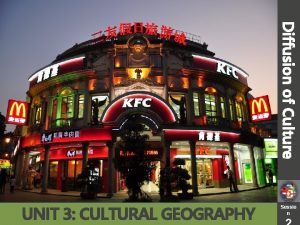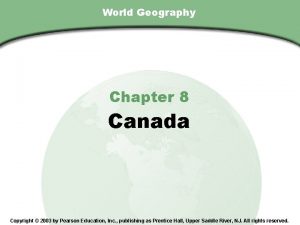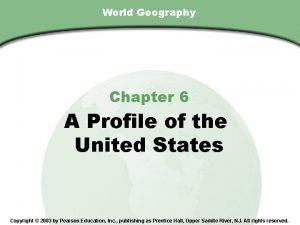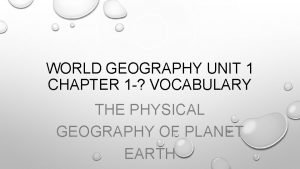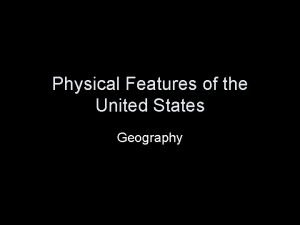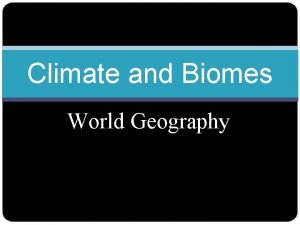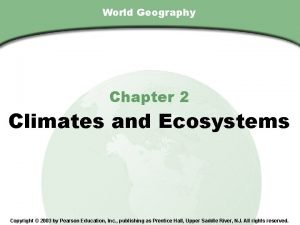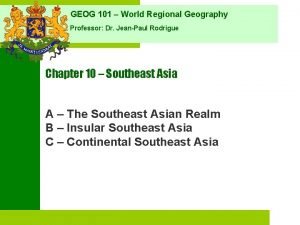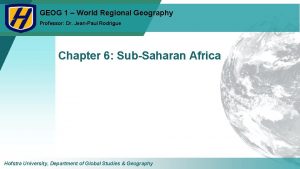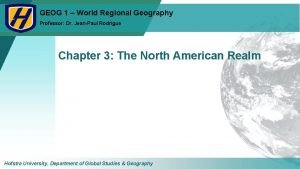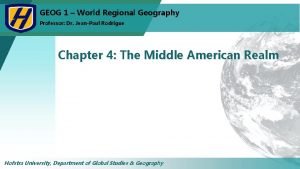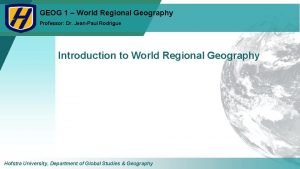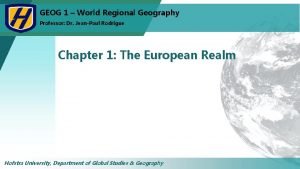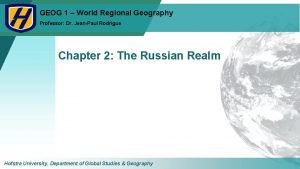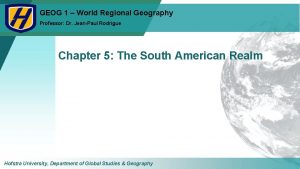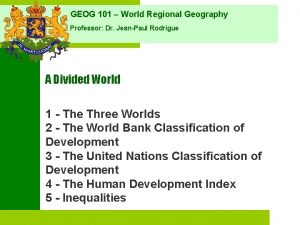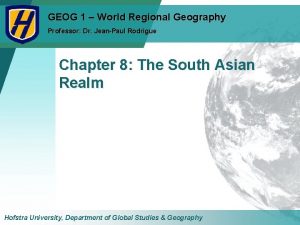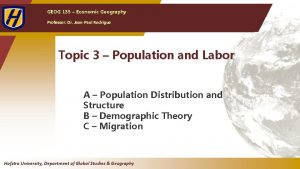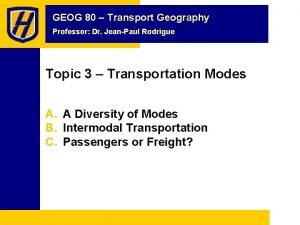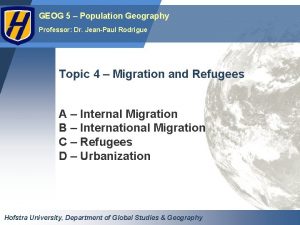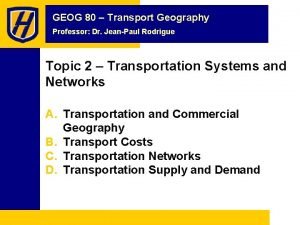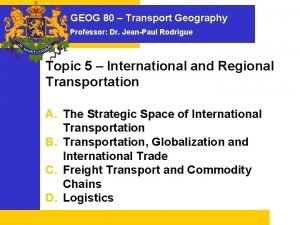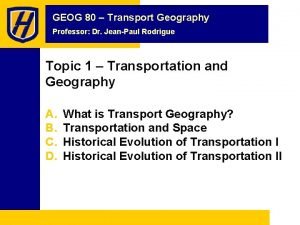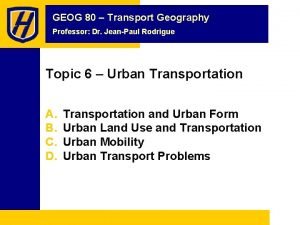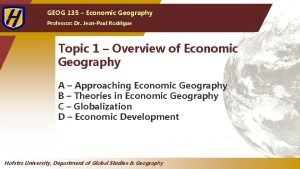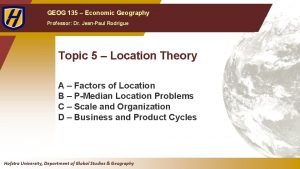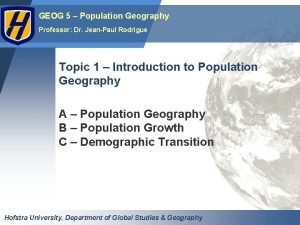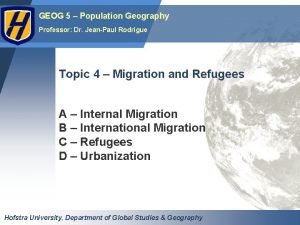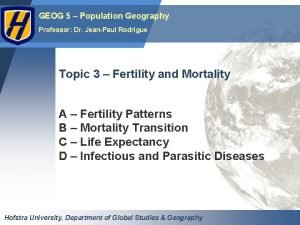GEOG 1 World Regional Geography Professor Dr JeanPaul


































- Slides: 34

GEOG 1 – World Regional Geography Professor: Dr. Jean-Paul Rodrigue Chapter 11: The Austral and Pacific Realms Hofstra University, Department of Global Studies & Geography


Defining the Austral Realm ■ Two countries: • Dominant Australia. • Smaller New Zealand. ■ Realm at a crossroads: • Strains of diversity (Maori in NZ and Aborigines in Australia). • Economic connections (Raw materials towards East Asia; Tourists). • Political debates (Immigration, Indigenous land rights).

Land Environment ■ Physiographic contrasts related to tectonics: • Australia at the center of its own tectonic plate: • Tectonic stability. • Little difference in relief. • New Zealand at the border of the Australian and Pacific plates: • Common earthquakes. • Mountainous.

World’s Main Tectonic Plates

Land Environment Climates ■ Australia: • Latitudinal position. • Tropical in the north. • Eastern humid temperate. ■ Interior isolation: • Mediterranean in the south. • Desert and steppe interior (Outback). ■ New Zealand: • Wholly under influence of Southern and Pacific oceans. • Moderate, moist conditions.

Land Environment: The Southern Ocean ■ Southern Ocean surrounding Antarctica: • Bounded by a marine transition known as Subtropical Convergence. • Cold, dense waters meet warmer waters of other three oceans. • Change in temperature, chemistry, salinity, and marine fauna. ■ Also known as the West Wind Drift, as the body of water circulates clockwise around Antarctica

Land Environment: Biogeography ■ From Wallace’s Line to Weber’s Line: • Proposed the boundary line of Australia’s fauna. • Challenged and replaced. ■ Distinctive Australia: • Land of marsupials (offspring are birthed into a pouch). • Early separation of Australian landmass; unique branches in biological evolution. • Vegetation: • Species diversity. • Specialized climactic adaptations. ■ Biogeography: study of fauna and flora in a spatial perspective What is particular about the physical geography and biogeography of the Austral realm?

Australia: Historical Geography ■ Early Aboriginal societies were doomed by the arrival of Europeans. ■ Coastal settlements as centers of seven colonies: • Straight-line delimitation. • Surviving Aboriginals located in Northern Territory.

Australia: Historical Geography ■ Successful Federation ■ Commonwealth of Australia, 1901 ■ Six States and two Federal Territories: • Northern Territory to protect the interests of Aboriginals there. • Australian Capital Territory around Canberra. ■ Federation • A communal association among territories sharing autonomy with a central government. • In contrast to the unitary state, where power is concentrated in a strong, central government.

Australia: Sharing the Bounty ■ Distance • An imposed remoteness from without and a divisive part of life within: • Expense of travel and shipping in and out of Australia. • Expense of traveling within and around Australia. • Economic and social self reliance. ■ Immigrants • New immigration policy focused on skilled immigrants and relatives of earlier immigrants. • Quota on asylum-seekers, but diversity is a contentious issue. • Immigrants account for most of the population growth.

Australia: Sharing the Bounty ■ Core and Periphery • • Population is concentrated in the eastern and southeastern core area: Secondary core area in the southwest In between is the vast periphery called the Outback. Spatial arrangement is a result of physiography. ■ Urban culture • 82 percent urban. • Coastal orientation. ■ The Cities • Australian cultural identity and sameness of urban/rural landscapes: • Clean and orderly. • High-quality urban public infrastructure.

Australia: Economic Geography ■ Agricultural Abundance • Livestock: • Sheep-raising and wool. • Beef products, along with refrigeration. • Dairying near urban areas. • Crops: • Commercial grain farming. • Sugarcane in warm, humid coastal areas. • Mediterranean crops. • Diverse crops in irrigated areas.

Australia: Economic Geography ■ Mineral Wealth What characterizes the economic geography of Australia, particularly the effects of distance? • Diverse and abundant mineral resources: • New finds are still being made. • Economic focus / dependency on exporting raw materials. • Largest mineral port in the world (Port Hedland). ■ Manufacturing’s Limits • Historical import-substitution industries: • Local entrepreneurs encouraged to set up their own industries to produce goods cheaper than they could be exported, largely due to transport costs. • Diversified, yet domestic orientation. • Dwarfed by primary sector prominence. ■ Australia’s economic mainstays: • Services, like tourism, then, commodity exports. • Growth and affluence are paid for by mines and farms.

Australia: Australia’s Challenges ■ Aboriginal Issues • In 2008 formal apology was issued for mistreatment of Aborigines. ■ Aboriginal land issue: • Major geographic implications. • Vast areas potentially subject to Aboriginal claims. • Mainly, not solely, an Outback issue. ■ Land-rich Aboriginals are dirt poor: • Complex issues involving the role of government, tribal

Australia: Australia’s Challenges ■ Immigration Issues • Immigration has been an issue since the beginning. • 95 percent European ancestry; eugenic immigration policies kept it this way until 1970 s (White Australia Policy). • Change in policy permitting larger numbers of non-European immigrants. • Today, East and South Asian immigrants outnumber both European immigrants and natural increase. • 25% of Australia’s population is now foreign born. • Fickle changes in immigration quotas. • Immigration needs continue for skilled-labor demands.

Australia: Australia’s Challenges ■ Environmental degradation of Australia: • • Both Aboriginal and European damage. Deforestation. Extinction, endangered, and threatened ecologies. Introduction of invasive species had very negative impacts (e. g. rabbits and cats). • Climatic variability: • Arid dominance. • Vulnerability to seasonal or permanent climate changes. ■ Growing awareness: • Tempered by those who fear environmentalism will be an obstacle for economic growth.

Australia’s Place in the World ■ Australia as a republic? • Ending its status as a British Commonwealth. ■ Relations with: • Indonesia and East Timor • Australia’s self-serving diplomatic maneuverings. • Papua New Guinea (PNG) • A projected pipeline plan causes questions of motive. ■ Australia’s global identity: • Wider global presence or just within Asia and Pacific Rim? • Growing connections with Asian and Pacific Rim.

New Zealand ■ New Zealand’s Polynesian Maori would have been a part of the Pacific realm: • But for European colonization. ■ Two large mountainous islands, surrounded by scattered smaller islands: • Combined territory larger than Britain. • Prone to volcanoes and earthquakes.

New Zealand ■ One of the leading “green” societies in the world: • Long-active Green Party; country has an established environmental conservation program. • New Zealand is ranked first in the world on a range of environmental indices. • Approximately 30 percent of its land is protected. • More than 70 percent of its energy is from renewables: • Nuclear-free country. • Environmental courts hear cases involving environmental decisions.



Defining the Realm ■ Sea Hemisphere: • Seas cover nearly an entire hemisphere. • Fragmented, culturally complex realm. • Total land area: • Roughly equal to Texas and New Mexico. • But 90 percent of land is Island of New Guinea. ■ Outside the realm: • Indonesia, Philippines, Australia, and New Zealand.

Defining the Realm: High and Low Islands ■ High islands • • • Volcanic origins. High elevations/rugged relief. Well-watered (rain shadow). Good soils, some agriculture. Tend to have larger populations; (New Caledonia, Hawaii). ■ Low islands • • Majority of realm’s islands. Small populations (e. g. Marshall Islands, Kiribati). Coral formation (atolls) thus little fresh ground water. Low elevation/relief. Vulnerable to drought and sea level rise/tsunami. Fishing, coconut palm, no minerals. Tourism and internet domains.

Atoll Formation

Barrier Island (Osprey Reef)

Colonization and Independence if the Pacific Realm ■ Most have been colonized or annexed. ■ Changing politics: • Some have stayed colonies. • Some have become independent. • Some are somewhere in between. ■ Island nations are rather disadvantaged in a world of large area states. ■ ‘Nuclear isolation’: • The United States (Marshall Islands) and France (French Polynesia) conducted hundreds of nuclear tests from the 1950 s to the 1990 s. • Lead to a sharp increase in cancer prevalence.

The Pacific Realm and its Marine Geography ■ Marine geography is a field encompassing a variety of approaches to studying the oceans and seas. ■ Vast Pacific Ocean: • Where Pacific waters meet surrounding shores. • Incorporates several seas: • Sea of Japan. • East China. • South China Seas. • Pacific coastal countries compete for jurisdiction over the waters that bound them. The Pacific Realm is an oceanic realm. Explain what it entails.

The Pacific Realm and Its Marine Geography: The State at Sea ■ Territorial sea: the ocean area where all the rights of a coastal state would prevail: • Beyond that lay the high seas as the free and open seas unfettered by national interests. • Continental shelves, as the offshore continuation of coastal plains, became a new littoral frontier to establish boundaries. ■ Scramble for the Oceans • Precipitated by the claims of jurisdiction over the continental shelf. • Political claims were then issued for territorial seas without a significant continental shelf to base them.

Exclusive Economic Zones in the Pacific

The Pacific Realm: The Risk of Climate Change ■ Marshall Islands • 29 coral atolls totaling 180 square kilometers of land mass. • Japanese dependency from 1914. • Administered by the UN (United States) since 1945. • Nuclear tests from 1946 to 1962. • Independence in the 1990 s. • Regional rise of sea levels of 1 feet since 1985. • Risk of relocating a population of 70, 000.

Antarctica ■ ■ Ice dome – 3. 2 km thick at pole 5. 5 million square miles (compare North America 7. 7 million) Multiple Claims The Antarctic Treaty, 1961 • Promotes scientific collaboration. • Prohibits military activity. • Territorial claims are held in abeyance.


Conclusion: Five Challenges of World Regional Geography ■ Economic • Economic development and regional disparities; an enduring uneven world? ■ Demographic • Regional differences in population growth and decline. The pressure of migration (and refugees). ■ Political • New regional political agreements? Devolution? Enduring regions of political instability? ■ Environmental • Resource depletion and climate change. Regions of environmental stress. ■ Cultural • The loss of regional identities? Cultural mosaics?
 World regional geography
World regional geography Promotion from assistant to associate professor
Promotion from assistant to associate professor Unit 1 geog. of ga/ga’s beginnings
Unit 1 geog. of ga/ga’s beginnings Free floating subdivisions
Free floating subdivisions Natural hazards definition ap human geography
Natural hazards definition ap human geography Geography dse
Geography dse Geog 214
Geog 214 Geog
Geog Samuel haskell
Samuel haskell Mezzogiorno map leaving cert
Mezzogiorno map leaving cert Ap human geography frq examples
Ap human geography frq examples 5 themes of geography ap human geography
5 themes of geography ap human geography Stateless nation
Stateless nation World geography final jeopardy
World geography final jeopardy World history final exam study guide
World history final exam study guide Secondary sector geography definition
Secondary sector geography definition World geography terms
World geography terms World geography unit 9 lesson 1
World geography unit 9 lesson 1 Chapter 16 world geography
Chapter 16 world geography Https://world-geography-games.com
Https://world-geography-games.com Web quest: geography of the spanish speaking world
Web quest: geography of the spanish speaking world How does wind affect weather and climate
How does wind affect weather and climate Islands off of florida
Islands off of florida 2021-2022 q1 9 week world geography cba
2021-2022 q1 9 week world geography cba World geography chapter 3 climates of the earth
World geography chapter 3 climates of the earth World geography unit 1 test
World geography unit 1 test Holt world geography today
Holt world geography today Define transculturation
Define transculturation World geography chapter 8 section 1
World geography chapter 8 section 1 World geography chapter 6 section 1
World geography chapter 6 section 1 World geography unit 1 vocabulary
World geography unit 1 vocabulary World geography
World geography World geography
World geography World geography
World geography World geography chapter 2 review answers
World geography chapter 2 review answers


